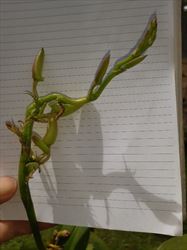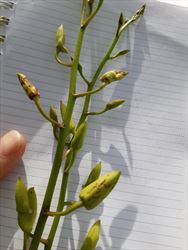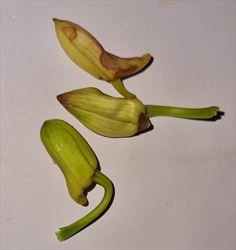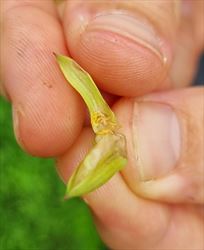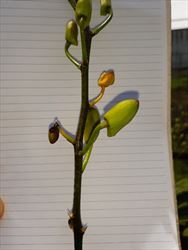Dendrobium midge. It is also known as blossom midge, orchid maggot, orchid blossom midge.
Pacific Pests, Pathogens, Weeds & Pesticides - Online edition
Pacific Pests, Pathogens, Weeds & Pesticides
Dendrobium midge (518)
Contarinia maculipennis. It is a member of the Cecidomyiidae. Here it is known as Contarinia species as it has not been formally identified.
Asia (Japan, Thailand), North America (Florida, Hawaii), the Caribbean (Barbados), Europe (in greenhouses in The Netherlands, and eradicated on several occasions), Oceania. CABI does not list any countries in the Pacific. An outbreak occurred in Fiji in April 2021, with Contarinia maculipennis the likely cause.
Orchids, hibiscus, jasmine, frangipani, capsicum, eggplant and tomato, bitter gourd and, the ornamental, Pseuderanthemum laxiflorum. Of all the hosts that have been reported, dendrobium species seem to be the most susceptible and, possibly, bitter gourd. (Note, one of the leafy cabbages of Melanesia is Pseuderanthemum whartonianum.)
A serious insect pest of orchids, caused by a fly midge, especially damaging on Dendrobium species. Brown scaring occurs on the main flower stems, sometimes accompanied by curling and other distortions (Photo 1). The flower buds show the most obvious symptoms: they become deformed and discoloured, with holes, brown spots and streaks that often broaden due to secondary fungal infections (Photos 2&3). Maggots are often present in unopened buds (Photo 4). Affected buds drop prematurely (Photo 5).
Eggs are laid into the open end of the younger flower buds, and hatch in 1-2 days into small (2.5-3 mm long) white larvae (up to 30 in each flower bud). Later, the maggots become yellow (Photo 6). At maturity, after 5-7 days, the maggots leave the plant by curling and uncurling their body in a spring-like action, falling to the soil where they burrow into the top layer to pupate. The adult fly emerges about 14-21 days later. Adults are like miniature mosquitoes, about 1.5 mm long, with long banded legs, large eyes, long antennae, spotted wings, and wingspans of 2.5-3 mm. The adults lives for about 4 days only. The life cycle depends on temperature: the duration of the life stages given here are those recorded in Hawaii. .
The midge favours high humidity and a damp medium in which to pupate, and thrives under the conditions ideal for growing orchids.
Spread over short distances occurs by the spring-like action of the larvae moving them between the plants. Longer spread, within and between countries is associated with the international trade in cut-flowers and nursery stock (cuttings). Although a weak flyer, spread is also possible over long distances in wind.
The impact of Dendrobium midge is significant. Flower buds remain closed, and become deformed and discoloured. Even lightly damaged flower buds that manage to open show symptoms on the petals, resulting in unmarketable plants. This has been the result of infestations in Hawaii, Japan and now Fiji. The result in Japan has been that some growers have ceased cultivating orchids, and others have increased applications of pesticides - on Okinawa Island the frequency of application has doubled since the introduction of Dendrobium midge. In Hawaii, infestations are often very high and difficult to manage. The impact on other hosts has not been detailed, but in Hawaii, the midge was considered a pest before the first reports of attacks on Dendrobium species. In Japan, bitter gourd is attacked in the field, whereas other hosts have neither been reported damaged in fields nor in greenhouses.
However, outbreaks of the midge in greenhouses in The Netherlands have resulted in little extra production costs, through loss of crop and increase use of pesticides, as outbreaks to date have been few.
Look for deformed stems with brown streaks, and unopened flower buds with holes, spots, streaks. Look for white to yellowish larvae inside the buds. Look for flower buds that have rots and have fallen off the stems.
BIOSECURITY
Contarinia maculipennis is not well distributed throughout the world and there is a high risk that it will continue to spread to those countries yet free from infestation. Particular attention should be given to its likelihood of spread on nursery stock (cuttings) and cut flowers. In many countries producing orchids, cultivation is year-round, and often in open fields, so the chance of contamination of plants and plant parts is high. However, buds on cut flowers are the greater risk as they may contain eggs and larvae; cuttings do not (or should not) carry flower buds, although cuttings are usually rooted in coir chips and this may be infested with pupae.
NATURAL ENEMIES
None known outside its native range. In Thailand, the midge is present but not considered a problem in field cultivated orchids.
CULTURAL CONTROL
Before planting:
- Avoid establishing orchid nurseries near places where alternative hosts are present (check under Hosts).
During growth:
- Regular monitoring: Check for symptoms of bud infection (weekly is ideal), for buds that have dropped, and for the presence of maggots inside unopened buds.
- Hygiene measures. Remove infected flower buds and those that have fallen, and destroy by burning.
RESISTANT VARIETIES
Possibly, Denbrobium and perhaps Vanda species are more susceptible to the midge than other species of orchids, and those of other species in plant families that are hosts. Tomato varieties with petals that keep tightly fitted until the time of opening are thought to be less susceptible.
CHEMICAL CONTROL
Previously recommendations suggested the used of non-systemic diazinon and systemic Orthene, but use of these broad spectrum organophosphate insecticides are no longer advised because of negative impact on human health and the environment. There is also evidence that the pest has developed resistance to organophosphates and carbamates. Neither diazinon nor dimethoate are registered for use in the EU. However, alternative pesticides are difficult to recommend. In Japan, a combination of methomyl, neonicotinoids (imidacloprid or thiametoxam), and teflubenzuron. Of the three, only the neonicotinoids were thought to be effective, mainly because of their systemic activity.
The broad-spectrum insecticide abamectin has been used and may offer a solution. It is derived from a soil-dwelling Streptomyces species.
____________________
When using a pesticide, always wear protective clothing and follow the instructions on the product label, such as dosage, timing of application, and pre-harvest interval. Recommendations will vary with the crop and system of cultivation. Expert advice on the most appropriate pesticides to use should always be sought from local agricultural authorities.
AUTHORS Mani Mua & Grahame Jackson
Information from Osborne LS et al. (Undated) A serious new pest is causing significant problems for dendrobium and hibiscus growers. University of Florida. (https://mrec.ifas.ufl.edu/lso/pestalrt/midgefin1.htm); and Jones S (2021) Orchid blossom midges. (https://www.aos.org/orchids/orchid-pests-diseases/orchid-blossom-midges.aspx); and Thompson B (2014) Blossom midge on dendrobium orchids.Pest management decision guide: green and yellow list. CABI, Barbados; and Pest risk analysis Contarinia maculipennis. (https://english.nvwa.nl/documents/plant/plant-health/pest-risk-analysis/documents/pest-risk-analysis-contarinia-maculipennis); and from Hara AH, Niino-DuPonte RY (2002) Blossom midge in Hawaii - a pest on ornamentals and vegetables. Cooperative Extension Service, College of Tropical Agriculture and Human Resources. University of Hawai'i at Manoa. Photo 1 Elizabeth Willhite, USDA Forest Sservice, Bugwood.org. Contarina gall midge spp. (Contarina sp.) Photos 1&2,4 Wilco Liebregts, Eco-Consult Pacific, Suva, Fiji.
Produced with support from the Australian Centre for International Agricultural Research under project HORT/2016/185: Responding to emerging pest and disease threats to horticulture in the Pacific islands, implemented by the University of Queensland, in association with the Pacific Community.
